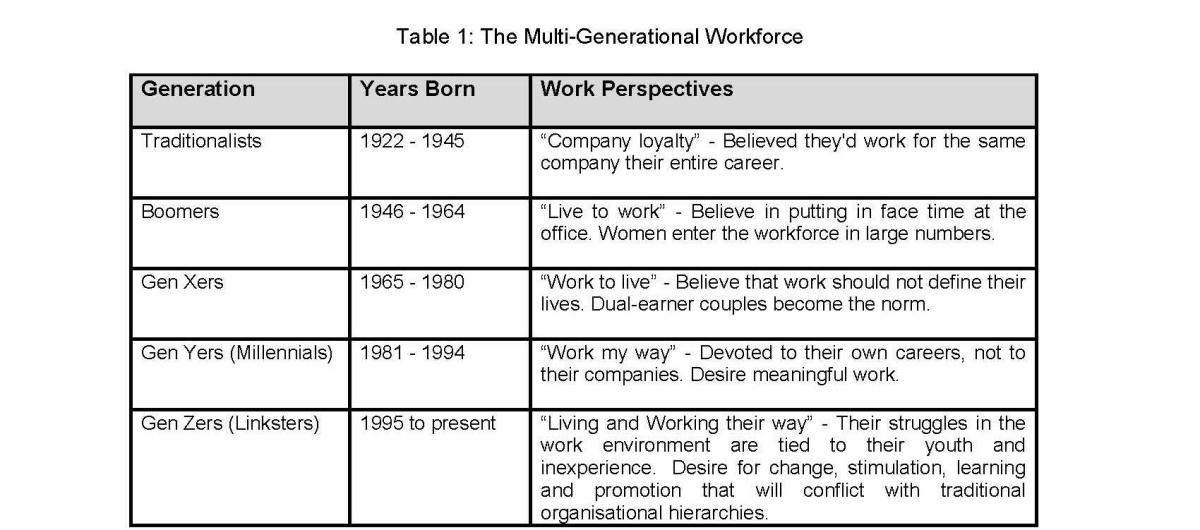
Unlocking the benefits of a multi-generational workforce in Singapore
By Prof Sattar BawanySingapore business is becoming progressively more global. Services and products offered by businesses are also becoming more focused and targeted at specific demographic segments.
Besides many organizations today have customers all over the world who demand excellent services and products that meet up their diverse needs, expectations and priorities. Simultaneously, the composition of the workforce is also changing significantly across the Globe.
Never before have four generations worked side by-side in the workplace.
After World War II, the Traditionalist generation, born 1922 to 1945, tended to work at the same employer for an entire career.
Beginning with the Boomers, born 1946–64, women and ethnic groups began entering the workforce in increasing numbers, bringing different needs and perspectives to the workplace.
As the Gen Xers entered the workforce, they increased job hopping in an effort to increase their income and/or to balance their lifestyle.
Although some employers made accommodations in response to the demographic shifts, the basic work model — top down, command and control, one size fits all, 8–5 workday — did not radically change.
Now, the emergence of the digital-savvy Millennials or Gen Yers has the potential to change the face of work to be more collaborative, to use virtual teams, to use social media, and to offer more flexible work hours.
The Fifth generation, Gen Zers or The Linksters has started coming into the workforce. The five generations and their birth years are depicted in Table 1.(See Table 1)
A major challenge for today’s Traditionalist and Baby Boomer managers is to figure out how to develop younger workers into tomorrow’s managers under a new business environment.
A pivotal question for managers is, “Do we want our legacy to be of mentoring and empowering the next generations, or of fighting them tooth and nail?”
Organizations that embrace generational differences in values, ways of getting things done, and ways of communicating will thrive.Challenges in Managing a Multigenerational Workforce
Demographic and social trends will have a significant impact on the workforce in the coming years. In today's struggling global economy, it is more important than ever for organisations leverage the knowledge, skills and abilities of all workers, from all generations.
By capitalising on the strengths and values of different generations, business leaders can create a sustainable competitive advantage for their organisations.
Organisations struggle with the challenges of effectively managing a more diverse workforce. These challenges often relate to variation in perspective, values and belief systems as a result of generational differences and are further complicated due to the age differences between managers and employees.
The assumption - that people of varying ages will understand each other or have the same perspective and goals, is far from true. In order to be successful, managers need to understand and value the diversity resulting from generational differences, varying perspectives and differing goals.
Each generation brings different experiences, perspectives, expectations, work styles and strengths to the workplace. Despite the perceived "generation gap" from differing views and potential conflict, organisations have the opportunity to capitalise on the assets of each generation to achieve competitive advantage.
Each brings unique assumptions to the job. As a result, events in the workplace are often interpreted differently by individuals in different generations.
What may seem like good news to a Boomer might well be an unsettling and unwelcome development to a member of Generation X. Things that members of Gen Y love often seem unappealing or frivolous to those in older generations.
Like any other generation, Gen Z or the Linksters it brings its own mind-set into the workforce. They are called Linksters because no other generation has ever been so linked to each other and to the world through technology. Their struggles in the work environment are tied to their youth and inexperience.
They are complete digital natives and cannot function without communicating through social media. They desire for change, stimulation, learning and promotion that will conflict with traditional organisational hierarchies.
Leading and Engaging a Multigenerational Workforce
When employees join an organization, they're usually enthusiastic, committed, and ready to be advocates for their new employer. Simply put, they're engaged.
But often, that first year on the job is their best.
Gallup Organization research reveals that the longer an employee stays with a company, the less engaged he or she becomes. And that drop costs businesses big in lost profit and sales, and in lower customer satisfaction.
In fact, Gallup estimates that actively disengaged employees -- the least productive -- cost the American economy up to US$350 billion per year in lost productivity.
Managers who harness this unprecedented opportunity for growth, development, and collaboration, and build bridges between generations, will thrive in particular in today’s turbulent economic landscape.
For managers who have four generations of employees sitting in a meeting or working on a project, it can seem like each generation has its own worldviews, priorities, career models, motives and values.
They need to enhance their understanding of generational characteristics and the impact of their own management practices on each of these groups, so that they can leverage on the strengths of each generation.
Taking full advantage of the multi-generational workforce will enable employers to effectively attract and retain employees, build teams, deal with change, and increase employee engagement.
Impact of leadership effectiveness on employee engagement and organisational success
Organisations need to deliver service value and build good customer relationships in order to generate sustainable results through their satisfied and loyal customers.
Employees being at the forefront of the service delivery chain hold the key to building this satisfied and loyal customer base (See Figure 2).
Employees who are engaged and motivated are instrumental in delivering the service experience for the client which will results in customer engagement.
The level of employee engagement is dependent on the “Organisational Climate” (sometimes known as Corporate Climate), which here simply refers to “how employees feel about working in the organisation/business unit/department/division.” Organisational climate is the process of quantifying the “culture” of an organisation.
It is a set of properties of the work environment, perceived directly or indirectly by the employees, that is assumed to be a major force in influencing employee behaviour and engagement.
We know that leaders create, transform and manage organisational cultures. The leader’s values, beliefs and leadership styles will impact the organisation’s climate. We need “Level 5 Leaders” who demonstrate ontological humility and possess emotional mastery. They also need to possess essential integrity in discharging their day to day role and responsibilities towards engaging the employees.
In his book, Good to Great, Jim Collins examines how a good company becomes an exceptional company. The book introduces a new term to the leadership lexicon – Level 5 leadership.
Level 5 refers to the highest level in a hierarchy of executive capabilities. Leaders at the other four levels may be successful, but are unable to elevate companies from mediocrity to sustained excellence.
Level 5 leadership challenges the assumption that transforming companies from good to great requires larger-than-life-leaders. The leaders that came out on top in Collins' five-year study were relatively unknown outside their industries. The findings appear to signal a shift of emphasis away from the hero to the anti-hero.
According to Collins, humility is a key ingredient of Level 5 leadership. His simple formula is Humility + Will = Level 5. "Level 5 leaders are a study in duality", notes Collins, "modest and wilful, shy and fearless."
Conclusion
Increasing generational diversity and technological change is causing a transformation in the way employers must manage human resources.
The homogenous human capital model of the past simply will not work with such diverse cohorts in the workforce. It is time to throw out the one-size-fits-all model of talent management and embrace a more flexible model.Conclusion
The diversity in the workforce today may be a challenge to HR and business leaders.
However, they do provide an organisation with a positive force as they each bring varied sets of skills and life experiences to the workplace. If managed properly, organisations can definitely see improved productivity and employee engagement.
Managers who harness this unprecedented opportunity for growth, development, and collaboration, and build bridges between generations, will thrive.
For managers who have four or five generations of employees sitting in a meeting or working on a project, it can seem like each generation has its own worldviews, priorities, career models and motives. Managers need to develop an understanding of generational characteristics and the impact of their own management practices on these groups.
They also need to leverage the strengths of each generation. Taking full advantage of the multi-generational workforce will enable employers to effectively attract and retain employees, build teams, deal with change, and increase employee engagement.


























 Advertise
Advertise










